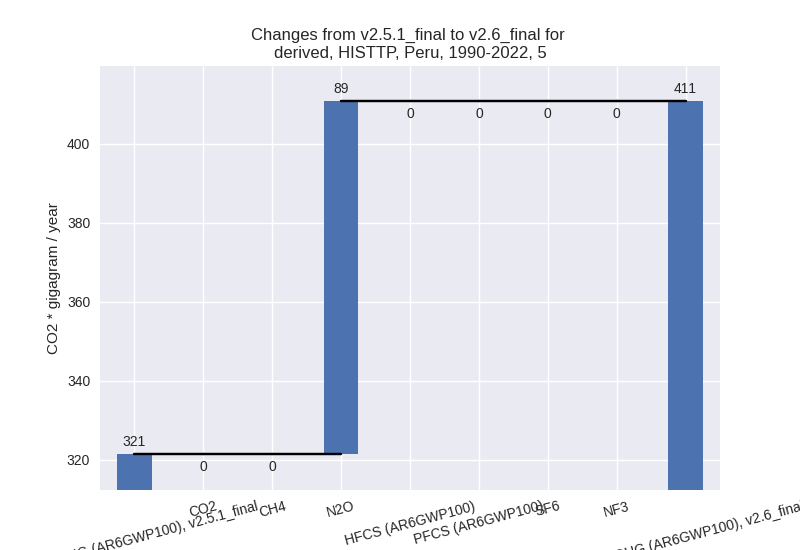Changes in PRIMAP-hist v2.6_final compared to v2.5.1_final for Peru
2024-09-24
Johannes Gütschow
Change analysis for Peru for PRIMAP-hist v2.6_final compared to v2.5.1_final
Overview over emissions by sector and gas
The following figures show the aggregate national total emissions excluding LULUCF AR6GWP100 for the country reported priority scenario. The dotted linesshow the v2.5.1_final data.
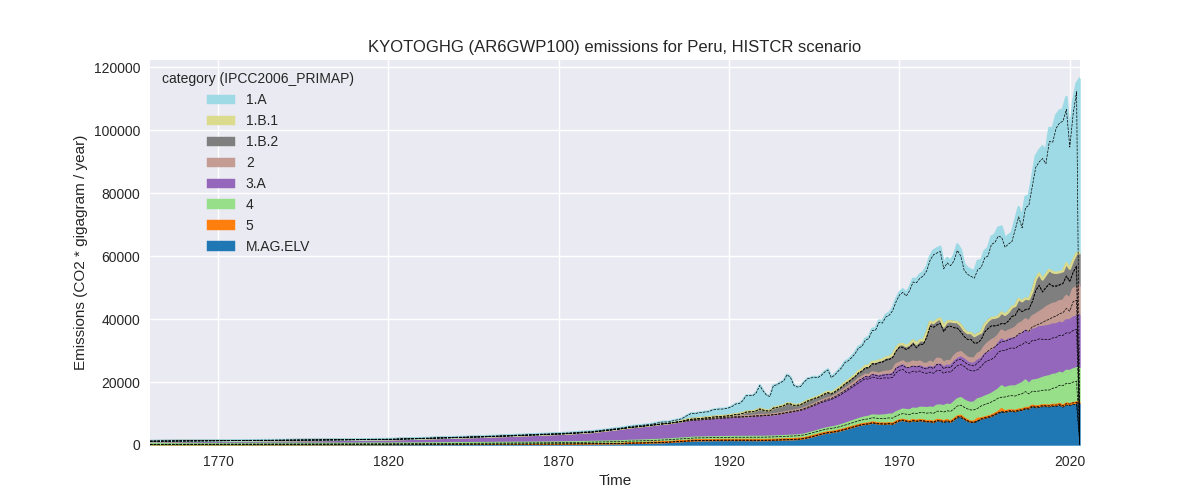
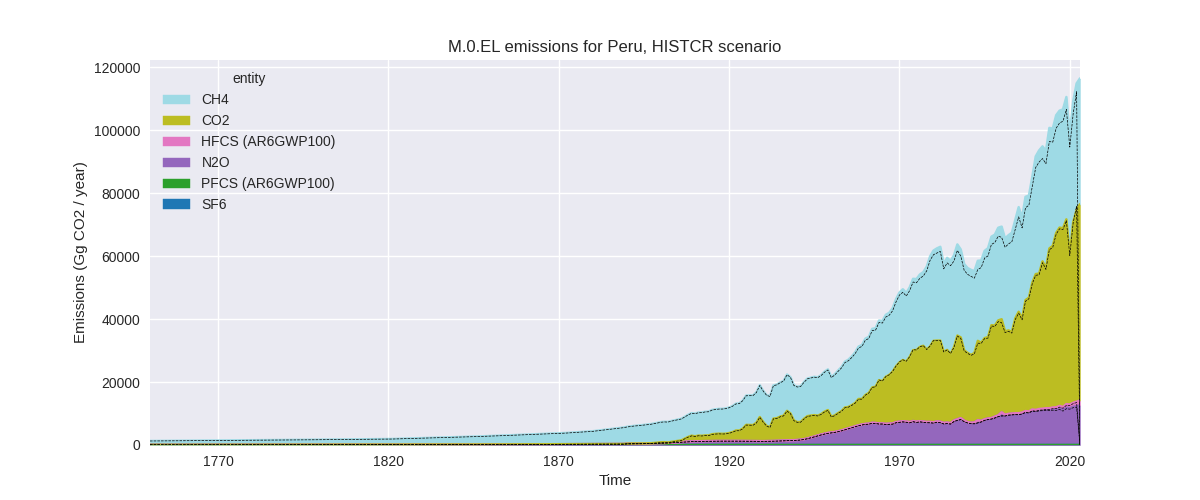
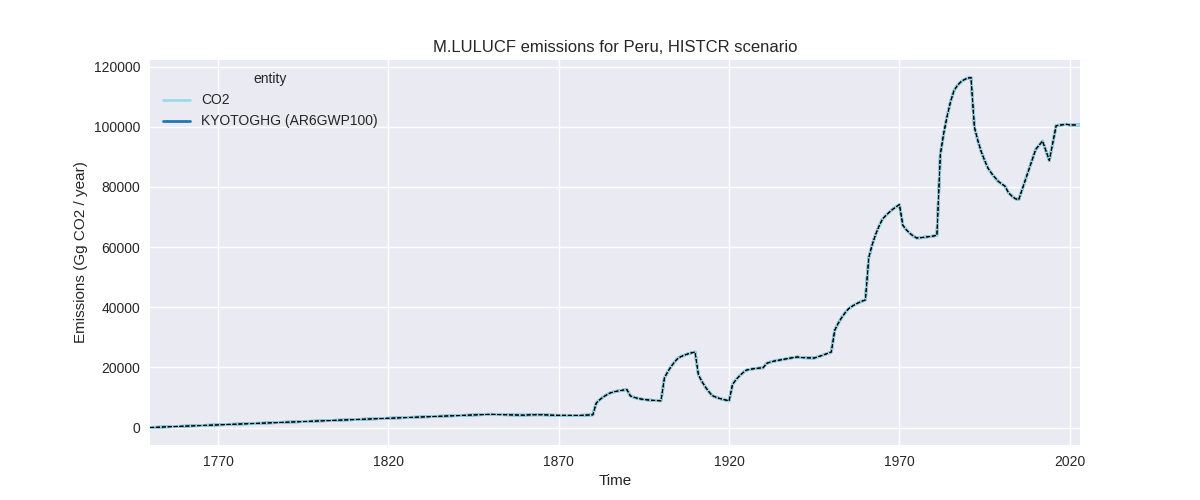
The following figures show the aggregate national total emissions excluding LULUCF AR6GWP100 for the third party priority scenario. The dotted linesshow the v2.5.1_final data.
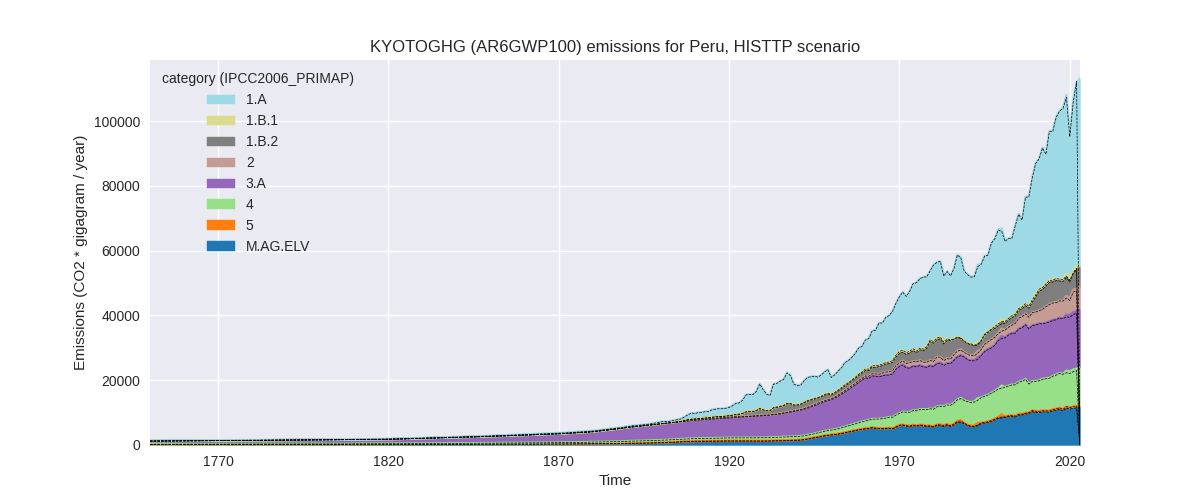

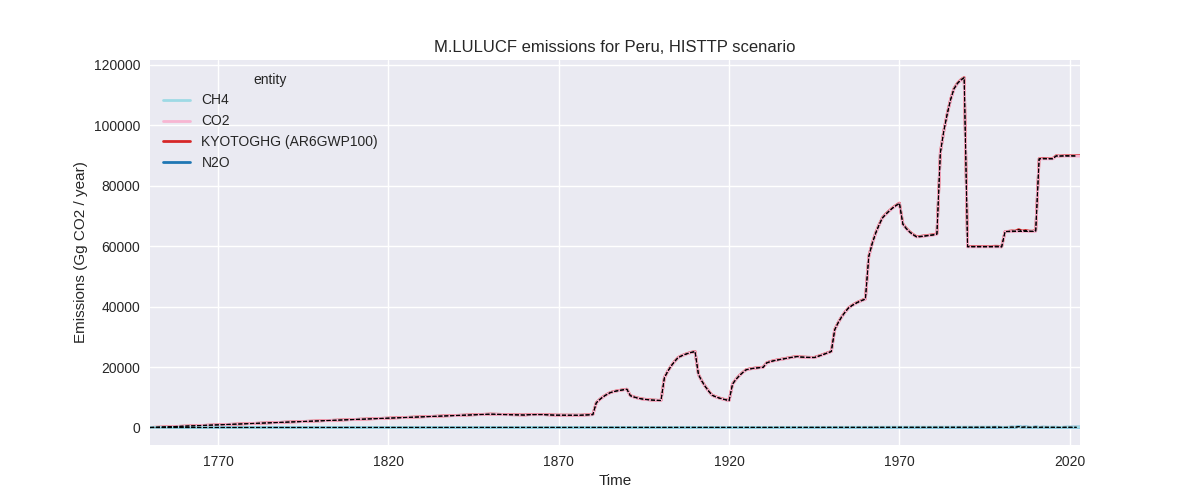
Overview over changes
In the country reported priority scenario we have the following changes for aggregate Kyoto GHG and national total emissions excluding LULUCF (M.0.EL):
- Emissions in 2022 have changed by 2.3%% (2625.67 Gg CO2 / year)
- Emissions in 1990-2022 have changed by 4.1%% (3170.37 Gg CO2 / year)
In the third party priority scenario we have the following changes for aggregate Kyoto GHG and national total emissions excluding LULUCF (M.0.EL):
- Emissions in 2022 have changed by -0.7%% (-751.38 Gg CO2 / year)
- Emissions in 1990-2022 have changed by 0.2%% (141.26 Gg CO2 / year)
Most important changes per scenario and time frame
In the country reported priority scenario the following sector-gas combinations have the highest absolute impact on national total KyotoGHG (AR6GWP100) emissions in 2022 (top 5):
- 1: 4, CH4 with 3785.24 Gg CO2 / year (56.5%)
- 2: 1.A, CO2 with -1301.02 Gg CO2 / year (-2.4%)
- 3: 4, N2O with 398.02 Gg CO2 / year (13718.6%)
- 4: 1.B.2, CO2 with -130.98 Gg CO2 / year (-16.4%)
- 5: 5, N2O with -116.22 Gg CO2 / year (-19.3%)
In the country reported priority scenario the following sector-gas combinations have the highest absolute impact on national total KyotoGHG (AR6GWP100) emissions in 1990-2022 (top 5):
- 1: 4, CH4 with 2850.84 Gg CO2 / year (57.9%)
- 2: 4, N2O with 313.91 Gg CO2 / year (11944.4%)
- 3: 5, N2O with 89.36 Gg CO2 / year (27.8%)
- 4: 1.B.2, CO2 with -46.22 Gg CO2 / year (-6.7%)
- 5: 1.A, CO2 with -36.97 Gg CO2 / year (-0.1%)
In the third party priority scenario the following sector-gas combinations have the highest absolute impact on national total KyotoGHG (AR6GWP100) emissions in 2022 (top 5):
- 1: 1.A, CO2 with -1364.67 Gg CO2 / year (-2.4%)
- 2: 4, CH4 with 674.94 Gg CO2 / year (6.5%)
- 3: 5, N2O with -116.22 Gg CO2 / year (-19.3%)
- 4: 4, N2O with 63.92 Gg CO2 / year (13.4%)
- 5: 1.B.2, CO2 with -25.39 Gg CO2 / year (-8.5%)
In the third party priority scenario the following sector-gas combinations have the highest absolute impact on national total KyotoGHG (AR6GWP100) emissions in 1990-2022 (top 5):
- 1: 5, N2O with 89.36 Gg CO2 / year (27.8%)
- 2: 4, CH4 with 72.47 Gg CO2 / year (0.8%)
- 3: 1.A, CO2 with -38.78 Gg CO2 / year (-0.1%)
- 4: 4, N2O with 22.83 Gg CO2 / year (6.9%)
- 5: 1.B.2, CO2 with -4.74 Gg CO2 / year (-1.1%)
Notes on data changes
Here we list notes explaining important emissions changes for the country. ’' means that the following text only applies to the TP time series, while means that it only applies to the CR scenario. Otherwise the note applies to both scenarios.
- We have no new country reported data for Peru. However, we fixed an error in the BUR3 submission where a waste subsector was missing from the sector sum. This leads to higher waste emissions for 2022 and cumulatively in the CR scenario.
- Energy CO2 emissions are lower in 2022 due to an EI data update (CR and TP)
- Changes in sectors 4 and 5 int he TP scenario are due to the removal of FAOSTAT data.
Changes by sector and gas
For each scenario and time frame the changes are displayed for all individual sectors and all individual gases. In the sector plot we use aggregate Kyoto GHGs in AR6GWP100. In the gas plot we usenational total emissions without LULUCF. ## country reported scenario
2022

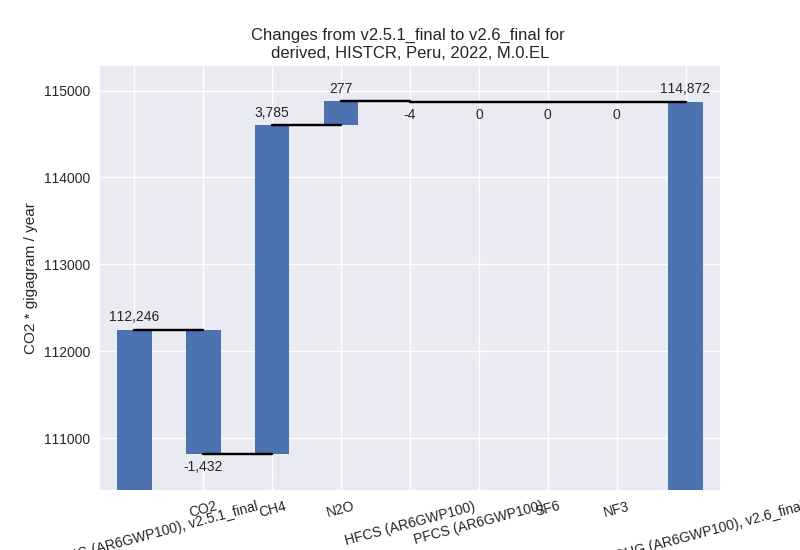
1990-2022
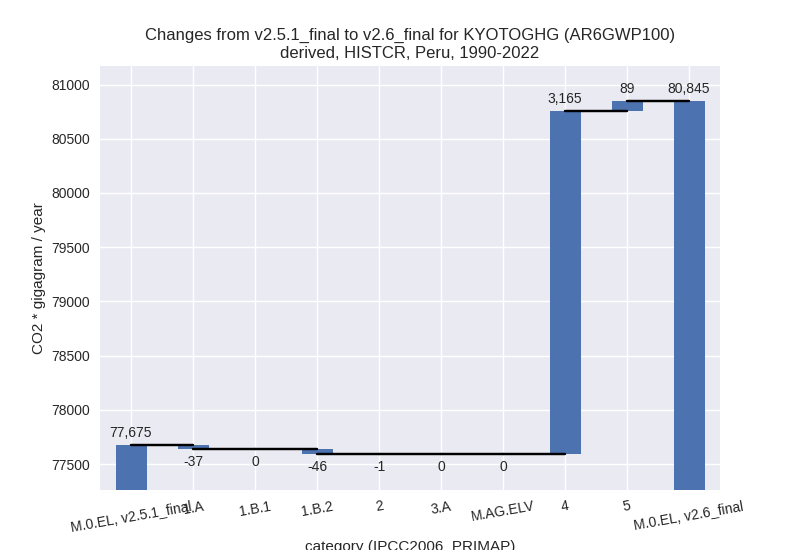
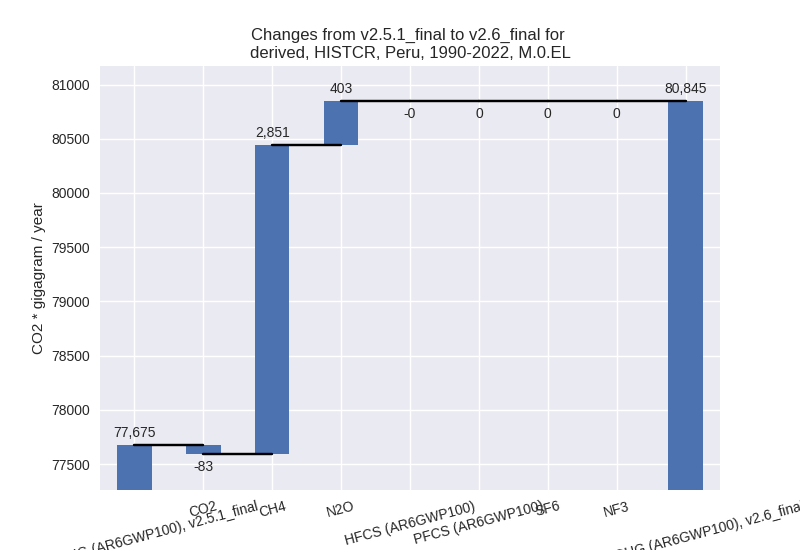
third party scenario
2022
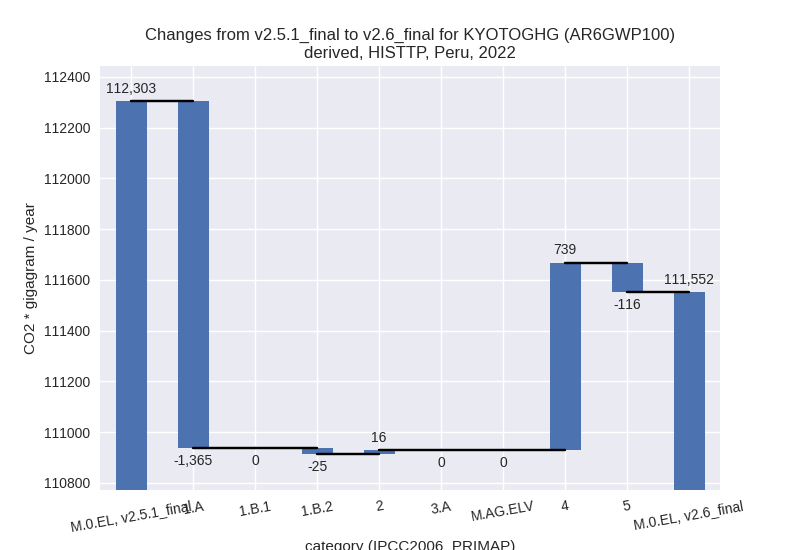
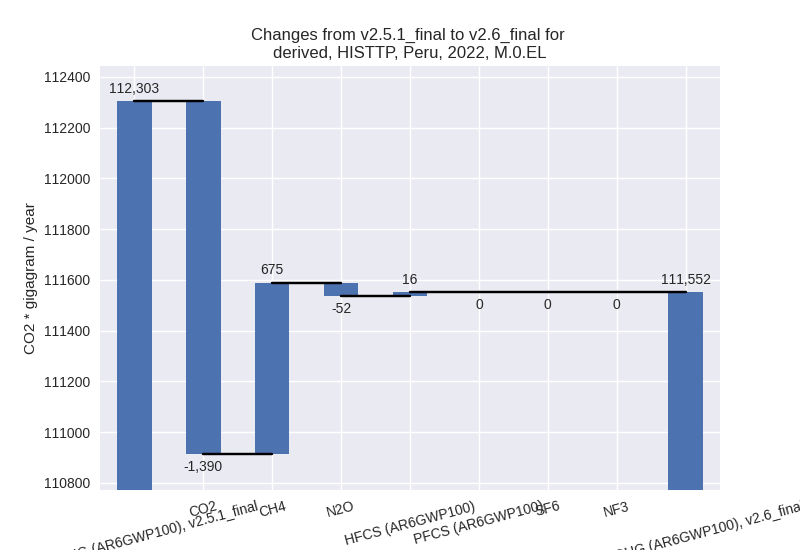
1990-2022
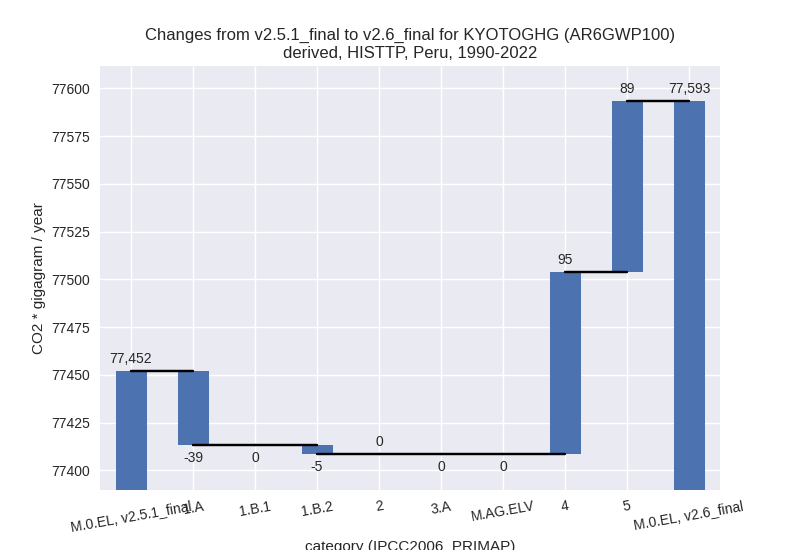
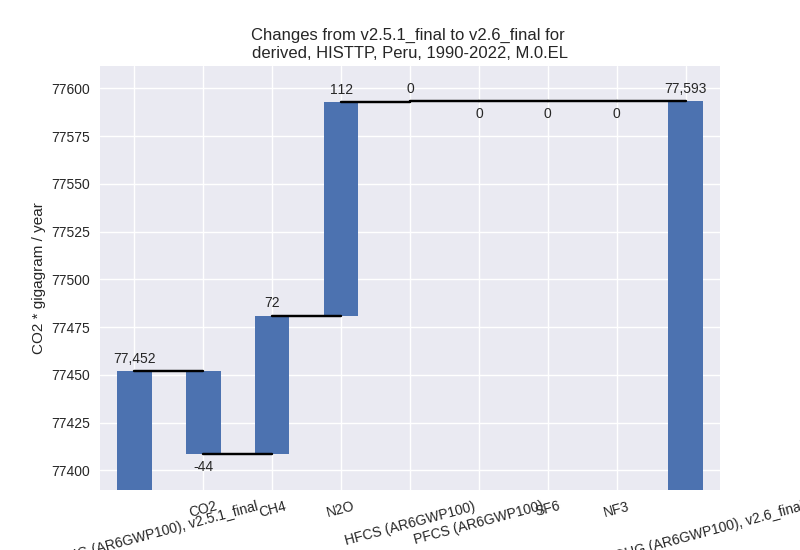
Detailed changes for the scenarios:
country reported scenario (HISTCR):
Most important changes per time frame
For 2022 the following sector-gas combinations have the highest absolute impact on national total KyotoGHG (AR6GWP100) emissions in 2022 (top 5):
- 1: 4, CH4 with 3785.24 Gg CO2 / year (56.5%)
- 2: 1.A, CO2 with -1301.02 Gg CO2 / year (-2.4%)
- 3: 4, N2O with 398.02 Gg CO2 / year (13718.6%)
- 4: 1.B.2, CO2 with -130.98 Gg CO2 / year (-16.4%)
- 5: 5, N2O with -116.22 Gg CO2 / year (-19.3%)
For 1990-2022 the following sector-gas combinations have the highest absolute impact on national total KyotoGHG (AR6GWP100) emissions in 1990-2022 (top 5):
- 1: 4, CH4 with 2850.84 Gg CO2 / year (57.9%)
- 2: 4, N2O with 313.91 Gg CO2 / year (11944.4%)
- 3: 5, N2O with 89.36 Gg CO2 / year (27.8%)
- 4: 1.B.2, CO2 with -46.22 Gg CO2 / year (-6.7%)
- 5: 1.A, CO2 with -36.97 Gg CO2 / year (-0.1%)
Changes in the main sectors for aggregate KyotoGHG (AR6GWP100) are
- 1: Total sectoral emissions in 2022 are 64845.68 Gg
CO2 / year which is 56.5% of M.0.EL emissions. 2022 Emissions have
changed by -2.2% (-1432.00 Gg CO2 /
year). 1990-2022 Emissions have changed by -0.2% (-83.19 Gg CO2 / year). For 2022 the
changes per gas
are:
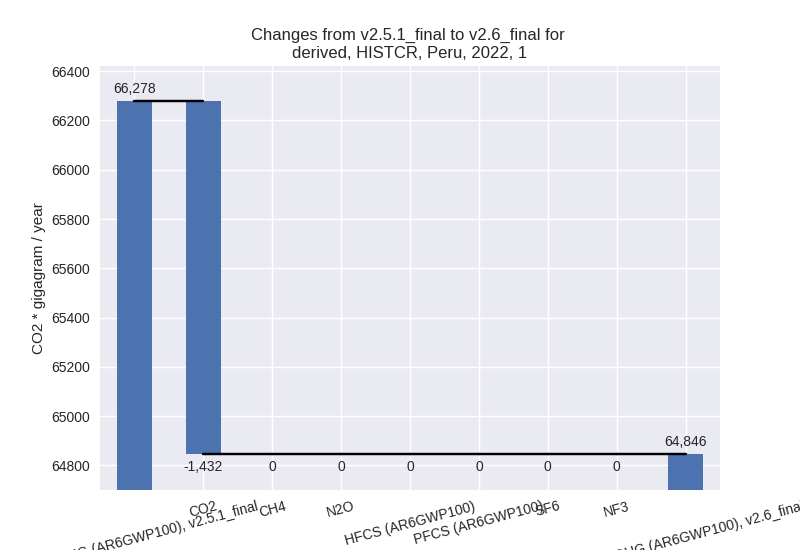
The changes come from the following subsectors:- 1.A: Total sectoral emissions in 2022 are 53984.74
Gg CO2 / year which is 83.3% of category 1 emissions. 2022 Emissions
have changed by -2.4% (-1301.02 Gg
CO2 / year). 1990-2022 Emissions have changed by -0.1% (-36.97 Gg CO2 / year). For 2022 the
changes per gas
are:
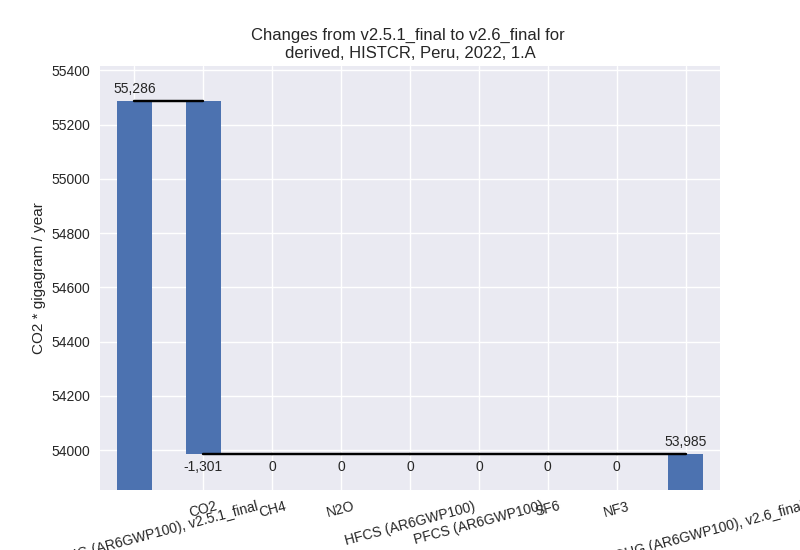
There is no subsector information available in PRIMAP-hist. - 1.B.1: Total sectoral emissions in 2022 are 171.47 Gg CO2 / year which is 0.3% of category 1 emissions. 2022 Emissions have changed by 0.0% (0.00 Gg CO2 / year). 1990-2022 Emissions have changed by 0.0% (0.00 Gg CO2 / year).
- 1.B.2: Total sectoral emissions in 2022 are 10689.47 Gg CO2 / year which is 16.5% of category 1 emissions. 2022 Emissions have changed by -1.2% (-130.99 Gg CO2 / year). 1990-2022 Emissions have changed by -0.6% (-46.22 Gg CO2 / year).
- 1.A: Total sectoral emissions in 2022 are 53984.74
Gg CO2 / year which is 83.3% of category 1 emissions. 2022 Emissions
have changed by -2.4% (-1301.02 Gg
CO2 / year). 1990-2022 Emissions have changed by -0.1% (-36.97 Gg CO2 / year). For 2022 the
changes per gas
are:
- 2: Total sectoral emissions in 2022 are 9262.09 Gg CO2 / year which is 8.1% of M.0.EL emissions. 2022 Emissions have changed by -0.1% (-9.37 Gg CO2 / year). 1990-2022 Emissions have changed by -0.0% (-0.56 Gg CO2 / year).
- M.AG: Total sectoral emissions in 2022 are 29386.67 Gg CO2 / year which is 25.6% of M.0.EL emissions. 2022 Emissions have changed by 0.0% (0.00 Gg CO2 / year). 1990-2022 Emissions have changed by 0.0% (0.00 Gg CO2 / year).
- 4: Total sectoral emissions in 2022 are 10890.06 Gg
CO2 / year which is 9.5% of M.0.EL emissions. 2022 Emissions have
changed by 62.4% (4183.26 Gg CO2 /
year). 1990-2022 Emissions have changed by 63.9% (3164.75 Gg CO2 / year). For 2022
the changes per gas
are:

For 1990-2022 the changes per gas are: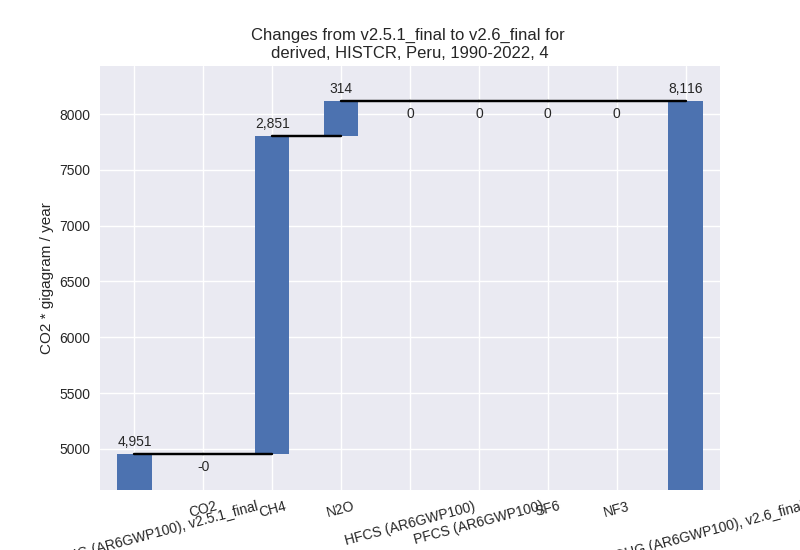
- 5: Total sectoral emissions in 2022 are 487.23 Gg
CO2 / year which is 0.4% of M.0.EL emissions. 2022 Emissions have
changed by -19.3% (-116.22 Gg CO2 /
year). 1990-2022 Emissions have changed by 27.8% (89.36 Gg CO2 / year). For 2022 the
changes per gas
are:

For 1990-2022 the changes per gas are:
third party scenario (HISTTP):
Most important changes per time frame
For 2022 the following sector-gas combinations have the highest absolute impact on national total KyotoGHG (AR6GWP100) emissions in 2022 (top 5):
- 1: 1.A, CO2 with -1364.67 Gg CO2 / year (-2.4%)
- 2: 4, CH4 with 674.94 Gg CO2 / year (6.5%)
- 3: 5, N2O with -116.22 Gg CO2 / year (-19.3%)
- 4: 4, N2O with 63.92 Gg CO2 / year (13.4%)
- 5: 1.B.2, CO2 with -25.39 Gg CO2 / year (-8.5%)
For 1990-2022 the following sector-gas combinations have the highest absolute impact on national total KyotoGHG (AR6GWP100) emissions in 1990-2022 (top 5):
- 1: 5, N2O with 89.36 Gg CO2 / year (27.8%)
- 2: 4, CH4 with 72.47 Gg CO2 / year (0.8%)
- 3: 1.A, CO2 with -38.78 Gg CO2 / year (-0.1%)
- 4: 4, N2O with 22.83 Gg CO2 / year (6.9%)
- 5: 1.B.2, CO2 with -4.74 Gg CO2 / year (-1.1%)
Changes in the main sectors for aggregate KyotoGHG (AR6GWP100) are
- 1: Total sectoral emissions in 2022 are 63292.30 Gg
CO2 / year which is 56.7% of M.0.EL emissions. 2022 Emissions have
changed by -2.1% (-1390.06 Gg CO2 /
year). 1990-2022 Emissions have changed by -0.1% (-43.52 Gg CO2 / year). For 2022 the
changes per gas
are:
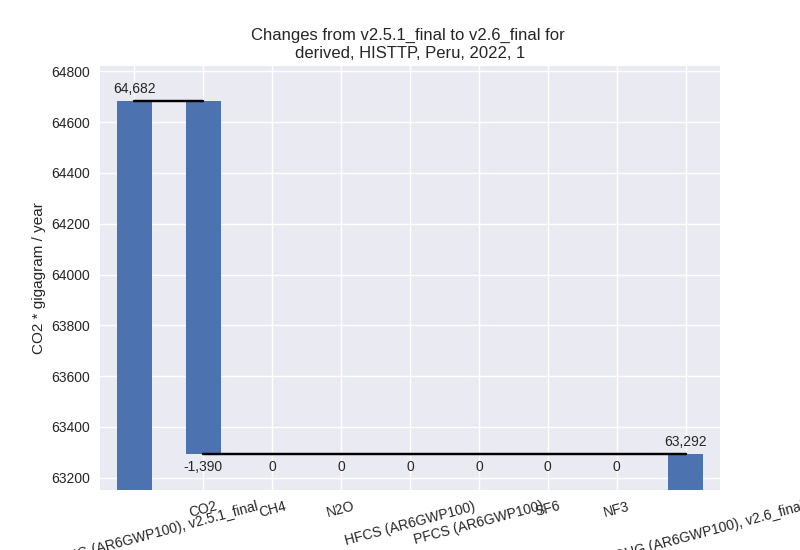
The changes come from the following subsectors:- 1.A: Total sectoral emissions in 2022 are 56376.11
Gg CO2 / year which is 89.1% of category 1 emissions. 2022 Emissions
have changed by -2.4% (-1364.67 Gg
CO2 / year). 1990-2022 Emissions have changed by -0.1% (-38.78 Gg CO2 / year). For 2022 the
changes per gas
are:
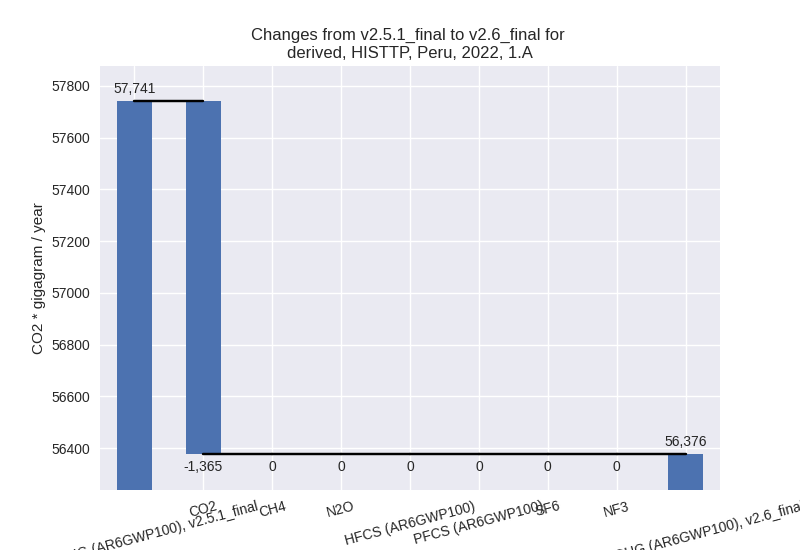
There is no subsector information available in PRIMAP-hist. - 1.B.1: Total sectoral emissions in 2022 are 320.91 Gg CO2 / year which is 0.5% of category 1 emissions. 2022 Emissions have changed by 0.0% (0.00 Gg CO2 / year). 1990-2022 Emissions have changed by 0.0% (0.00 Gg CO2 / year).
- 1.B.2: Total sectoral emissions in 2022 are 6595.28 Gg CO2 / year which is 10.4% of category 1 emissions. 2022 Emissions have changed by -0.4% (-25.39 Gg CO2 / year). 1990-2022 Emissions have changed by -0.1% (-4.74 Gg CO2 / year).
- 1.A: Total sectoral emissions in 2022 are 56376.11
Gg CO2 / year which is 89.1% of category 1 emissions. 2022 Emissions
have changed by -2.4% (-1364.67 Gg
CO2 / year). 1990-2022 Emissions have changed by -0.1% (-38.78 Gg CO2 / year). For 2022 the
changes per gas
are:
- 2: Total sectoral emissions in 2022 are 7004.53 Gg CO2 / year which is 6.3% of M.0.EL emissions. 2022 Emissions have changed by 0.2% (16.03 Gg CO2 / year). 1990-2022 Emissions have changed by 0.0% (0.10 Gg CO2 / year).
- M.AG: Total sectoral emissions in 2022 are 29145.97 Gg CO2 / year which is 26.1% of M.0.EL emissions. 2022 Emissions have changed by 0.0% (0.00 Gg CO2 / year). 1990-2022 Emissions have changed by 0.0% (0.00 Gg CO2 / year).
- 4: Total sectoral emissions in 2022 are 11621.87 Gg
CO2 / year which is 10.4% of M.0.EL emissions. 2022 Emissions have
changed by 6.8% (738.87 Gg CO2 /
year). 1990-2022 Emissions have changed by 1.0% (95.31 Gg CO2 / year). For 2022 the
changes per gas
are:
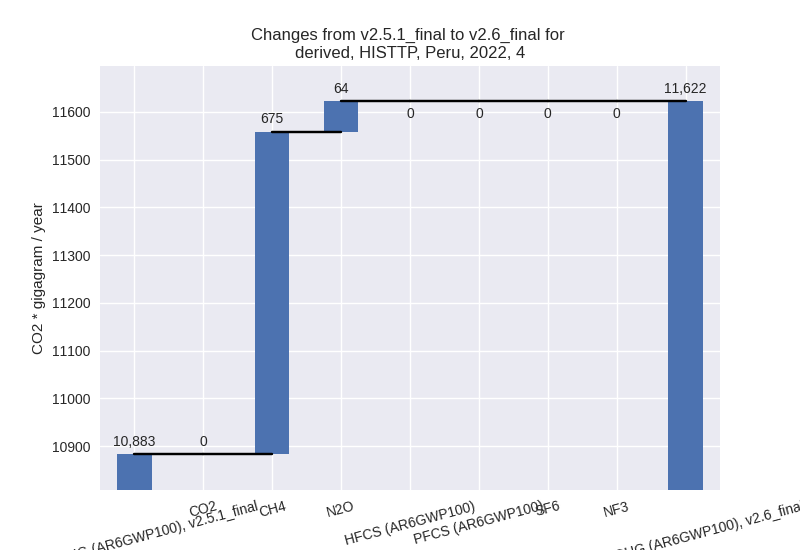
- 5: Total sectoral emissions in 2022 are 487.23 Gg
CO2 / year which is 0.4% of M.0.EL emissions. 2022 Emissions have
changed by -19.3% (-116.22 Gg CO2 /
year). 1990-2022 Emissions have changed by 27.8% (89.36 Gg CO2 / year). For 2022 the
changes per gas
are:

For 1990-2022 the changes per gas are: